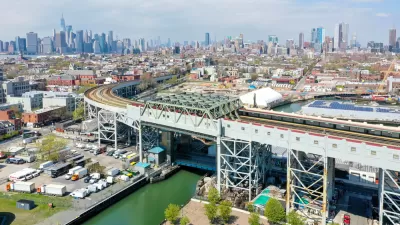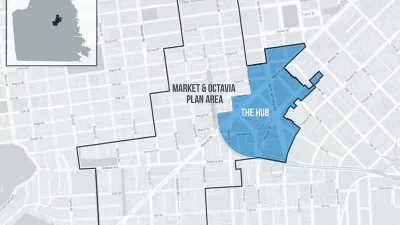Vast amounts of tech money have transformed the city's commercial spaces in unexpected ways.

Adrian Daub takes a closer look at the area around Church and Market streets in San Francisco to better understand the phenomenon of commercial spaces remaining empty after businesses have been priced out:
[Sparky’s diner] was first to go: in 2015 rent suddenly went up, the diner’s owner refused to pay, and Sparky’s was no more. Our usual ideas about gentrification suggest neighborhood standbys get replaced by fancy boutiques and brunch-centric eateries. Instead, after Sparky’s came … nothing. Elsewhere, too, long-term leases timed out, rents increased, and the old neighborhood hangouts disappeared.
The area has seen huge growth in the number of residents and upscale residential developments, but storefronts remain unoccupied, says Daub. "Developers make their money with luxury apartments aimed at high-salaried tech workers, while ground floor retail is an architectural and economic afterthought: giant spaces that any business would have trouble filling with life and justifying financially."
Daub points to California’s Proposition 13 and the cap on property taxes as a factor in this market dynamic. "Owners may pay Nixon-era property tax rates, while renting out those spaces at rates that have exploded in the last 40 years. They, too, can afford to let buildings sit empty."
San Francisco highlights the link between the technology industry and capitalism and the change that ingenuity and money can bring, says Daub. "But walk through parts of San Francisco today, and you get a different sense altogether: not an uncanny effectiveness, but a panicked swirl of homeless capital."
FULL STORY: Abandoned stores, empty homes: why San Francisco's economic boom looks like a crisis

Alabama: Trump Terminates Settlements for Black Communities Harmed By Raw Sewage
Trump deemed the landmark civil rights agreement “illegal DEI and environmental justice policy.”

Study: Maui’s Plan to Convert Vacation Rentals to Long-Term Housing Could Cause Nearly $1 Billion Economic Loss
The plan would reduce visitor accommodation by 25% resulting in 1,900 jobs lost.

Planetizen Federal Action Tracker
A weekly monitor of how Trump’s orders and actions are impacting planners and planning in America.

Waymo Gets Permission to Map SF’s Market Street
If allowed to operate on the traffic-restricted street, Waymo’s autonomous taxis would have a leg up over ride-hailing competitors — and counter the city’s efforts to grow bike and pedestrian on the thoroughfare.

Parklet Symposium Highlights the Success of Shared Spaces
Parklets got a boost during the Covid-19 pandemic, when the concept was translated to outdoor dining programs that offered restaurants a lifeline during the shutdown.

Federal Homelessness Agency Places Entire Staff on Leave
The U.S. Interagency Council on Homelessness is the only federal agency dedicated to preventing and ending homelessness.
Urban Design for Planners 1: Software Tools
This six-course series explores essential urban design concepts using open source software and equips planners with the tools they need to participate fully in the urban design process.
Planning for Universal Design
Learn the tools for implementing Universal Design in planning regulations.
Caltrans
Smith Gee Studio
Institute for Housing and Urban Development Studies (IHS)
City of Grandview
Harvard GSD Executive Education
Toledo-Lucas County Plan Commissions
Salt Lake City
NYU Wagner Graduate School of Public Service





























